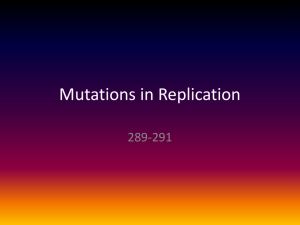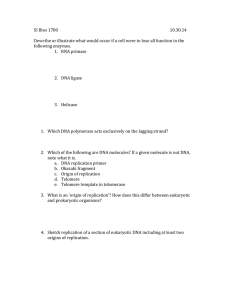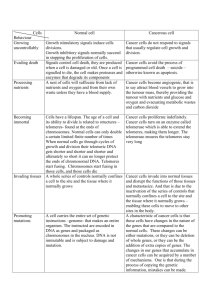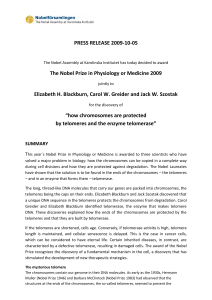PowerPoint
advertisement
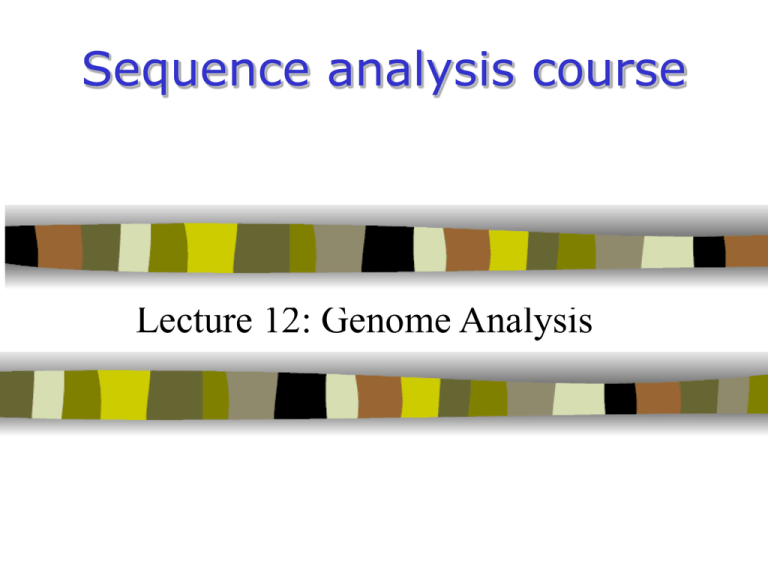
Sequence analysis course Lecture 12: Genome Analysis Telomeres Telomeres are specialized protein–DNA complexes that cap the ends of chromosomes. Like the plastic sleeves that stop shoelaces from unraveling, they protect the sequences that are needed for DNA to replicate when cells divide. Telomeres are enormously complicated machines made up of specialized DNA, an enzyme called telomerase, and protein complexes that interact with DNA. They function to regulate the lifespan of a cell by shortening with each cell division until they become too small to serve their function and cause the cell to cease dividing. When eukaryotic cells — those with distinct nuclei — first developed about 1.8 billion years ago, their chromosomes evolved to become linear in shape, rather than circular, as they were in prokaryotic cells, which lack nuclei. Many biologists have theorized that telomerase was born at the same time in order to protect the newly exposed ends of linear chromosomes. http://www.rockefeller.edu/pubinfo/news_notes/rus_051404_d.php Telomeres Without proper telomere structure, chromosomes become unstable and cells die. Across evolution, telomere DNA is composed of tandemly repeated short sequences with one strand rich in G and T, e.g. 5'-d(TTAGGG)-3' in vertebrates, and 5'-d(TTTTGGGG)-3' in Oxytricha nova. This G-rich strand extends past the duplex portion of the telomere to form a single strand 3' end. The telomere end binding protein from O. nova recognizes and binds this single strand DNA to form a unique capping complex. Human Telomer-DNA comprises 5000-15 000 bases bound by a large number of proteins. At each replication the telomere shrinks as 50-500 TTAGGG are lost, eventually leading to cell death. Tumor cells use telomerase to counter this process by elongating the telomere. Telomerase is implicated in cancer -- So-called G-quartett DNA structures are believed to inhibit telomerase. ALSO READ: http://blog.bioinfo-online.net/2005/11/23/normal-chromosome-ends-elicit-a-limited-dna-damage-response/ Structure of a telomere protein-DNA complex. (a) Overview of the telomere end binding protein from Oxytricha nova complexed with both single strand DNA (ssDNA) and a G-quartet stabilized DNA dimer (G-quartet). The G-quartet DNA structure adopts an ordered helical structure with stacked bases while the ssDNA adopts an irregular, non-helical, non-G-quartet structure in a cleft formed between the alpha and beta protein subunits. (b) Close-up view of the G-quartet stabilized DNA dimer. One of the GGGGTTTTGGGG DNA strands is darker gray than the other one. 5' and 3' termini of each strand are labeled. Phosphorous atoms are yellow and phosphate oxygens are red. Four layers of G-quartets stack along the helical axis while the d(TTTT) nucleotides loop diagonally across either end of the helix. Electron density for sodium ions found at the center of each G-quartet is colored violet. Electron density peaks assigned to water molecules are colored cyan. Phylogenetic Footprinting •Phylogenetic footprinting is a method for the discovery of regulatory elements in a set of homologous regulatory regions, usually collected from multiple species. •It does so by identifying the best conserved motifs in those homologous regions. •The idea underlying phylogenetic footprinting is that selective pressure causes regulatory elements to evolve at a slower rate than the non-functional surrounding sequence. Therefore the best conserved motifs in a collection of homologous regulatory regions are excellent candidates as regulatory elements. •The traditional method that has been used for phylogenetic footprinting is to construct a global multiple alignment of the homologous regulatory sequences and then identify well conserved aligned regions. However, this approach fails if the regulatory regions considered are too diverged to be accurately aligned. Phylogenetic Footprinting Using phylogenetic footprinting to detect conserved TFBSs. This schematic diagram shows a hypothetical human gene aligned with its orthologs from three other mammals. Cross-species sequence comparison reveals conserved TFBSs in each sequence. Sequence motifs of the same shape (colored in green) represent binding-sites of the same class of transcription factors. TFBS1 and TFBS4 are conserved in all four mammals; TFBS3 represents a newly acquired, primate-specific binding site. TFBS2 and TFBS2' represent orthologous regulatory sites that have diverged significantly between the primate and rodent lineages. Blue rectangles represent TATA boxes. Phylogenetic Footprinting Blanchette, M. et al. Nucl. Acids Res. 2003 31:3840-3842; doi:10.1093/nar/gkg606 An example of a position-specific weight matrix of a TF-binding motif adapted from the TRANSFAC database The sequences that have been shown experimentally to bind to the human transcription factor GATA-1 have 14 positions, among which only positions 6–10 are fully conserved. Abbreviations: R, G or A (purine); N, any; S, G or C (strong); D, G or A or T. Twelve sequences were used to build this matrix. http://www.generegulation.com/pub/databases.html Legend to preceding Figure Fig. 1 Comparison of singlemarker LD with haplotype-based LD. a, LD between an arbitrary marker (at the 26th position, indicated with an asterisk) and every other marker in the data set using D. b, Multiallelic D is used to plot between the maximumlikelihood haplotype group assignment at the location of the 26th marker and that assignment at the location of every other marker in the data set. c,d, Repeat of the comparison in a and b but with respect to a second marker (at the 61st position) in the map. Both pairs of Legend to preceding Figure Fig. 2 Block-like haplotype diversity at 5q31. a, Common haplotype patterns in each block of low diversity. Dashed lines indicate locations where more than 2% of all chromosomes are observed to transition from one common haplotype to a different one. b, Percentage of observed chromosomes that match one of the common patterns exactly. c, Percentage of each of the common patterns among untransmitted chromosomes. d, Rate of haplotype exchange between the blocks as estimated by the HMM. We excluded several markers at each end of the map as they provided evidence that the blocks did not continue but were not adequate build a first or last block. In addition, four markers fell between blocks, which suggests that the recombinational clustering may not take place at a specific base-pair position, but rather in small regions.
